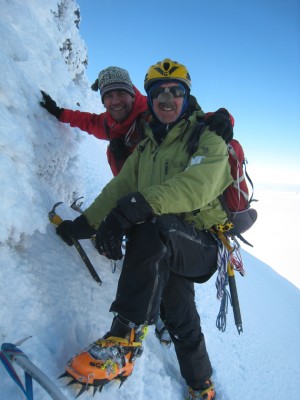A winter voyage to South Georgia had seemed like a great idea to Skip Novak and his crew aboard Pelagic Australis. But now ice was accumulating on deck and in the rig at an alarming rate
Southern winter, 19 August, and we were sailing on a broad reach in 30 knots true, an established south-westerly airstream sweeping up from the Antarctic. What appeared to be a stationary high well away to the west was blocking the usual depressions marching through this part of the Southern Ocean – ideal sailing conditions for us really, and the temperatures hovering between 4° and 7° of frost would not have otherwise been an issue. But even a light sea spray coming over the beam was causing substantial accumulation of ice on deck and up to three metres on the rig.
It was soon apparent that our choice of a very conservative sail plan – three reefs in the mainsail and our storm staysail – was the right one. Well, choices from that point on were moot, as the furling drum on the staysail was already the size of a frozen beach ball and the main halyard and reef lines were caked in centimetres of rime. Even with buckets of brine – if we’d had that 50kg of rock salt, which we didn’t – it would have been a mission to keep the running gear clear. We were committed, but confident in the GRIB files that we would see less wind as we approached the island, not more, and the sail plan, frozen in place, was good for more or less 50 knots of breeze.
Foredeck on all fours
For the second time that afternoon, now with the winter sun set and a moonless night in the offing, I armed myself with my coveted rubber hammer, wisely slung around my neck with a sail tie. I ventured onto the foredeck more or less on all fours, for another session in anger management, taking it out on what must have been a ton of ice decorating the pulpit, lifelines, furlers, sails and rigging.
It was not a crisis by any means and the audience in the doghouse amused themselves at my expense (they would all have some outdoor fun later), but it was noteworthy how quickly the ice grew even in this off the wind condition.
We had many blunt instruments on board – winch handles, axes, crowbars, metal pipes and more – but I was holding these back to mitigate any damage to the fabric of the boat by the overzealous. By the time I cleared the pulpit and started working aft on lifelines and rigging, the pulpit had already been seeded with another layer of the white stuff. There is no doubt that a few of us who knew better were contemplating what it would have been like in an upwind, head sea condition.
The British climber Stephen Venables and I hatched the idea of this mid-winter climbing trip while on a previous voyage to the Antarctic Peninsula in 2013. We had co-led two Shackleton Traverses in previous seasons, so were keen to do some climbing elsewhere on the island and we worked under the presumption that if October was a good month, well then August and September would be even better.
This theory was conveniently backed up by former South Georgia resident Tim Carr of Curlew fame who, with his wife, Pauline, had spent 14 years on the island. Likewise, SG lifer Pat Lurcock, perennial harbour master during the winter fisheries season, also claimed that August into September was the time to be there. The difference, though, was that they were based on the island so did not face the hurdle of actually getting there at this time of year.
First trip of the season
Annually, our first trip of the season to South Georgia is early October during the very beginning of spring. Temperatures are on the rise, but snow cover is usually still fast on the shore, making forays by ski and sled into the interior relatively soft starts. Colder than high summer, skiing and pulling conditions are optimum and generally the weather is more stable, with the tracks of the big lows often moving north of the island, resulting in less wind speed and longer periods of calm, sometimes measured in days rather than hours as is the case in high summer.
Then, too, we are more or less alone on the island well before the cruise ships arrive. However, it must never be forgotten that South Georgia is arguably one of the most inaccessible of sailing destinations, given its position and climate, which can only be described as harsh. It has no airstrip and there is no organised SAR facility whatsoever. You really are on your own, where self-rescue is the only rescue.
Who was crazy enough to join us for such a venture? Well, four of our team from 2013. Joined by another four, who would stay with the vessel while we camped ashore for 12-14 days – an ideal scenario to manage all expectations.







